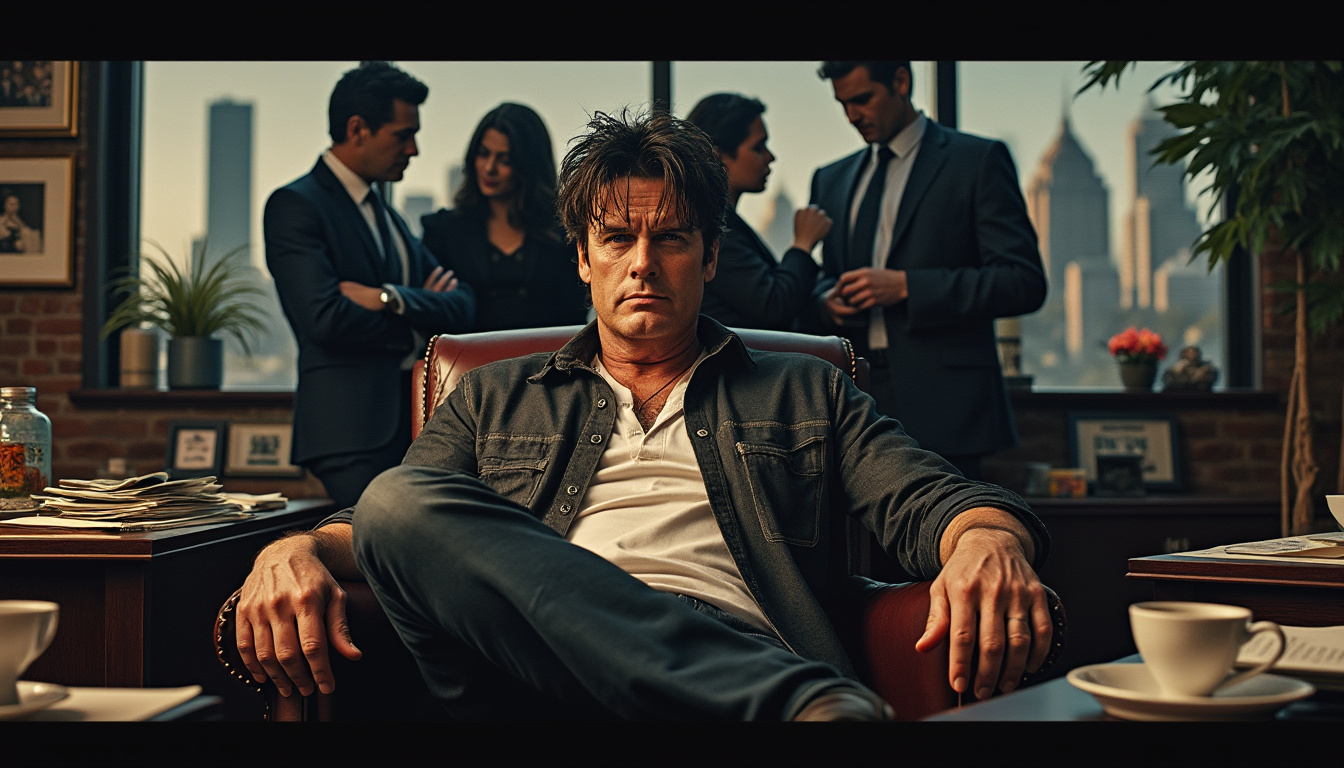On the 2011 firing of Charlie Sheen from the sitcom Two and a Half Men, few things are as striking as the drastic fall from grace he experienced during what many viewed as a spectacular meltdown. As one of the highest-earning television stars at the time, making nearly $2 million per episode, the abrupt end to his role as Charlie Harper left fans baffled. The complexities behind that moment have resurfaced with Sheen’s recent revelations in his memoir, The Book of Sheen, where he closely examines the unorthodox reasons for his tumultuous departure.
Inside Charlie Sheen’s Turbulent Relationship with Two and a Half Men
The saga of Charlie Sheen and Two and a Half Men reads almost like a modern-day Greek tragedy, where the lead protagonist spirals out of control amid fame and excess. The show, which aired on CBS, quickly became one of the network’s biggest successes, thanks in part to Sheen’s charismatic portrayal of an indulgent bachelor navigating life and love. However, behind the scenes, tension brewed, particularly between Sheen and the show’s creator, Chuck Lorre.

Publicly, Sheen’s struggles with substance abuse became alarming to fans. Many recall the infamous interview in which he declared himself a “winner” while exhibiting erratic behavior. Yet, this tumultuous period was a culmination of various factors, leading up to his firing. Observers note that the pressures of Hollywood fame can sometimes manifest in destructive ways. Not only did Sheen’s personal issues spiral out of control, but the media also played a significant role in stoking the flames of his downfall.
The relationship dynamics on set also suffered greatly during this period. Reports from People Magazine and Variety, among others, documented the friction between Sheen and Lorre, painting a picture of a creative partnership turned adversarial. The fallout was not just about personal conflicts; it extended to the entire cast and crew, creating an atmosphere charged with tension.
- Financial Success: At the peak of the show, Sheen was making nearly $2 million per episode.
- Public Persona: Sheen’s charm masked deeper struggles with addiction.
- Creator Conflicts: His relationship with Chuck Lorre deteriorated, directly impacting the series.
- Media Scrutiny: Constant media coverage exacerbated Sheen’s predicament.
The environment around Two and a Half Men painted a robust picture of a star spiraling, and the public’s perception shifted dramatically as Sheen faced more scrutiny. While the show continued to thrive in his absence, questions remained regarding the revelations he would eventually share about the bizarre reasons behind his exit.
The Surprising Role of Testosterone Cream in Sheen’s Meltdown
One of the most shocking aspects of Sheen’s explanation for his breakdown was the revelation about a legal testosterone cream that he claimed contributed significantly to his erratic behavior during the show’s later seasons. In The Book of Sheen, he describes how this substance, intended to improve his physical health, ended up altering his mental state. Sheen stated, “What I chose not to quit was the testosterone cream that I was slathering on in mind-altering gobs like a f**ken Pond’s commercial.”

Sheen insisted that while using testosterone was meant to help rejuvenate him, it led him down a darker path. He detailed how the substance can metabolize similarly to anabolic steroids, which are notorious for their performance-enhancing effects but also come with a range of side effects including mood swings and behavioral changes. This insight adds a layer of complexity to Sheen’s public breakdown. It aligns with a broader conversation surrounding the use of testosterone in Hollywood, where many actors resort to treatments to maintain their physique but may not fully comprehend the risks involved.
Moreover, Sheen’s claim raises important questions about the responsibility of medical professionals in prescribing such treatments, particularly in high-pressure environments like Hollywood. The fine line between seeking improvement and risking mental health deteriorates within the context of celebrity culture’s inherent pressures.
- Health Risks: Testosterone use can lead to unpredictable psychological effects.
- Misuse of Prescriptions: The potential for misuse in high-pressure celebrity environments exists.
- Responsibility of Medical Professionals: Clearer communication about risks is essential.
- Cultural Implications: The normalization of such substances in Hollywood raises underlying issues.
Ultimately, this new dimension of Sheen’s narrative reframes the understanding of his breakdown, suggesting that it wasn’t merely a result of addiction or erratic behavior but also linked to an attempt at self-improvement that backfired dramatically.
Media Amplification: How News Outlets Fueled Sheen’s Turmoil
The media landscape during Sheen’s public breakdown played a pivotal role in amplifying his struggles. Outlets such as Entertainment Tonight, E! News, and Rolling Stone endlessly covered his controversies, often turning personal crises into sensational on-screen narratives. The constant scrutiny not only affected Sheen’s mental well-being but also reshaped public perception, making him a target for ridicule rather than sympathy.
As the actor engaged in various highly publicized interviews, chunks of sensationalized soundbites became highlights, often overshadowing deeper issues at play. Critics argue this furor was exactly what Hollywood thrives on: drama, shock, and melodrama. The more outrageous Sheen’s comments became, the more press coverage he received, leading to a vicious cycle of negative publicity. A classic example is when he coined phrases like “winning” that soon became memes but belied an underlying struggle.
During this time, many viewers became desensitized to his struggles, interpreting them as a source of entertainment rather than a serious issue. This thinking can dangerously blur lines. The culture of clickbait journalism, particularly in the age of social media, raises standards for celebrity behavior, often pushing them toward more extreme actions for the entertainment of the masses. This destructive cycle is particularly relevant today, as ongoing discussions about mental health and the responsibilities of journalists press against the backdrop of celebrity culture.
- Clickbait Culture: Sensationalized headlines often overshadow important discussions about mental health.
- Desensitization: Continuous coverage leads to a skewed perception of celebrity struggles.
- Obligation of Outlets: Journalists must navigate the line between reporting and exploiting personal crises.
- Social Media’s Role: Platforms can amplify both voices and consequences of celebrity actions.
The media’s response to Sheen’s breakdown remains a poignant reminder of the responsibilities placed on journalists. As the discourse surrounding mental health evolves, so must the approach in covering the lives of public figures, especially those struggling in the spotlight.
A Reflection on Accountability: Sheen’s Personal Responsibility
Amid the chaos, Sheen has recently taken steps towards acknowledging his role in the events that transpired. He mentions in his memoir not only the external factors contributing to his actions but also reflects on the personal accountability he must face. By processing these past events, he suggests a pathway for both recovery and redemption. There’s a distinct sense of trying to reclaim narrative ownership, emphasizing the importance of recognizing one’s actions.
His candid discussions point toward a broader theme relevant in 2025: the necessity for celebrities to actively engage with their own narratives rather than allow societal perceptions to define them. The increasing trend of public figures coming forward with their stories stands as testament to both a shift in societal values and the growing importance of mental health awareness. Celebrities like Sheen serve as flashpoints for dialogue about substance abuse, mental health struggles, and the importance of seeking help.
- Personal Growth: Acknowledging one’s mistakes is crucial in any recovery journey.
- The Importance of Narrative Ownership: Celebrities can reshape their legacies through candid discussions.
- Impact of Mental Health Awareness: Opening dialogues can change societal attitudes.
- Seeking Support: Even public figures need to prioritize help and reconnect with themselves.
In taking responsibility for his past actions, Sheen not only paves the way for his own healing process but also sets an example for others facing similar struggles. His journey raises critical questions about support frameworks for those in similar positions, not just within Hollywood but globally.
Where Sheen Stands Today: Lessons Learned and Moving Forward
As Charlie Sheen continues to navigate life after his volatile exit from Two and a Half Men, his reflections offer a unique lens into the complexities of celebrity life, fame, and the ramifications of poor choices. The transition from being a tabloid sensation to a more introspective figure signals a hopeful narrative of recovery and resilience. His ongoing dialogue about mental health issues and their impact on personal lives plays a crucial role in dismantling stigma surrounding these topics.
The conversations that stem from his experiences should not only focus on the past but also consider how the entertainment industry can evolve to support its stars more effectively. The blend of humor, personal struggle, and life lessons resonates across myriad audiences, connecting his public turmoil with private pains experienced by many.
- Resilience: Sheen’s journey exemplifies the importance of bouncing back from adversity.
- Community Support: The entertainment industry must offer better frameworks for star recovery.
- Impact on Society: His story serves as a reflection of broader societal issues regarding fame and mental health.
- Future Aspirations: Sheen’s future endeavors could pivot towards advocacy and outreach.
The trajectory of Charlie Sheen’s life stands as a complex narrative rife with lessons about mental health, accountability, and the media’s role in shaping public perception. His story is indicative of a broader discourse surrounding how we perceive celebrity, failure, and ultimately, the path to redemption.


